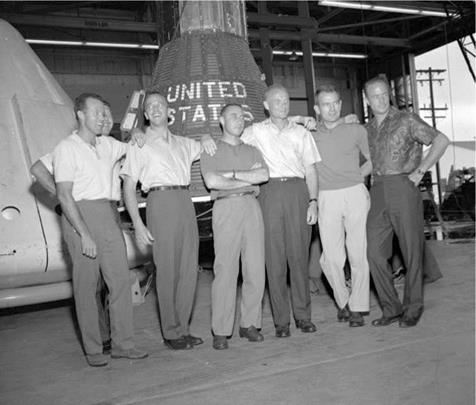Monkeys to Men
HEROES
An expectant hush descended over the journalists in the conference room of the Dolley Madison House, opposite Lafayette Park in downtown Washington, DC. It was the afternoon of 9 April 1959. Backstage, clad in civilian suits, two of them wearing bow ties, stood the United States’ first team of astronauts – the ‘Mercury Seven’. At 2:00 pm Eastern Standard Time, the presiding officer, Walt Bonney, finally spoke. ‘‘Ladies and gentlemen,’’ he began, ‘‘in about 60 seconds, we will give you the announcement you have all been waiting for: the names of the seven volunteers who will become the Mercury astronaut team.’’
Those volunteers – Scott Carpenter, Gordo Cooper, John Glenn, Virgil ‘Gus’ Grissom, Wally Schirra, Al Shepard and Donald ‘Deke’ Slayton – had been chosen after three months of careful screening of 110 experienced combat and test pilots. The list had gradually been reduced through a series of invasive and, in many cases, degrading medical and psychological evaluations. The pilots had been split into three groups, two of which were summoned secretly to the Pentagon in January 1959 for briefings on the effort to send a man into space. Afterwards, the 69 candidates from the first two groups had been asked if they wished to volunteer for further tests and, to the great surprise of many on the selection board, more than 90 per cent of them agreed. The third group, unneeded, was never called up. It had been assumed that the pilots would be so entrenched in their military careers that shifting to a civilian space project would hold little appeal. Already, some of the United States’ most accomplished test pilots – Chuck Yeager among them – had poured scorn on the idea of rocketing men into space atop converted ballistic missiles. Even Al Shepard’s father (himself a former military officer) expressed concern that his son had made the wrong decision. He would eat his words years later when Shepard not only became the first American in space, but also the fifth man to walk on the Moon.
Sixty-nine candidates rapidly dwindled to just thirty-two, who reported to Randy Lovelace’s aerospace medicine clinic in Albuquerque, New Mexico, for additional evaluations. Over the course of a week, every spot on the bodies of Shepard and the
|
The Mercury Seven. From the left are Gordo Cooper, Wally Schirra (partially obscured), Al Shepard, Gus Grissom, John Glenn, Deke Slayton and Scott Carpenter. Behind them is a Mercury capsule, which all of them but Slayton flew into space. |
others was sampled, measured, poked and prodded, with scarcely a muscle, bone or gland left untouched. Throats were scraped, stool and semen samples taken, electricity zapped into hands and intensely uncomfortable ‘steel eels’ inserted into rectums. Wally Schirra would later call Lovelace’s tests ‘‘an embarrassment, a degrading experience… sick doctors working on well patients’’.
Survivors of the clinic devised a tradition of inviting the newer candidates to dinner at a local Mexican restaurant. At one of these gatherings, the veterans each had at their feet a jug of urine, which they had been obliged to collect for medical purposes during their stay. One evening, accidentally, Gus Grissom knocked over his jug, but, thanks to the quick-thinking crowd of test pilots, was provided with a ready solution: to order more beer. Several rounds, and a number of trips to the lavatory, later, Grissom’s jug had its required amount of urine…
Still more tests followed at the Aeromedical Laboratory of Wright-Patterson Air Force Base in Dayton, Ohio, where the pilots withstood cold water pumped into their ears, sat for hours in overheated saunas, endured soundproofed and darkened isolation rooms, blew up balloons until they were out of breath, walked on treadmills until their heart rates soared to 180 beats per minute and were photographed from every conceivable angle and into every conceivable orifice. Many perceived the whole thing as excessive and a waste of time. “I’d flown combat missions and done operational test flying for 17 years by that point,’’ wrote Deke Slayton. “The fact that I’d survived should have told them all they needed to know about stress. At least putting me in the blackout chamber, they let me catch a nap!’’
Not only were the selectors looking for the most physically unbreakable men, they were also scrutinising their reactions to the tests and the testers. Would they crack, psychologically, under the unknown stresses imposed by the mysterious space environment? Personality questions prompted them to explore their individual motivations for wanting to become astronauts, their concerns about their health, their frustrations, their ‘thoughts’ and even whether their desires to fly jets and rockets arose from feelings of sexual inadequacy. The seven men eventually chosen, in addition to their combat and test flying credentials, were all highly intelligent – with IQs of between 131 and 141 – but, said psychologist George Ruff, all were ‘‘oriented toward action, rather than thought’’.











